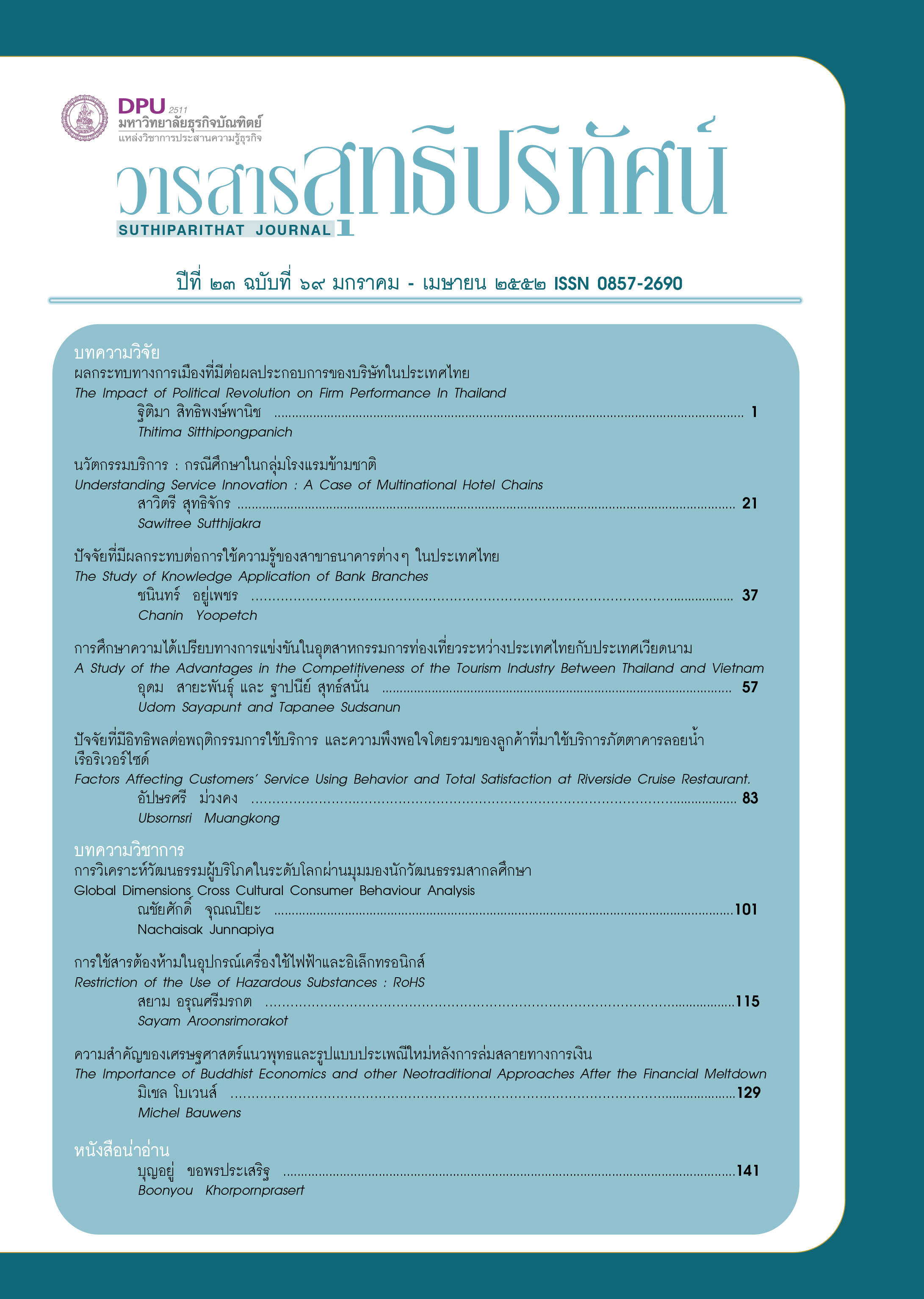ปัจจัยที่มีผลกระทบต่อการใช้ความรู้ของสาขาธนาคารต่างๆ ในประเทศไทย
คำสำคัญ:
การใช้ความรู้, การสื่อสารภายในองค์การและเครือข่ายทางสังคมบทคัดย่อ
การศึกษานี้มุ่งเน้นในปัจจัยที่มีผลกระทบต่อการใช้ความรู้ (Knowledge application) ของสาขาธนาคารในประเทศไทย ปัจจัยต่างๆ ในการศึกษานี้ได้แก่ การสนับสนุนทางด้าน เทคโนโลยีสารสนเทศ การทำงานเป็นทีมเครือข่ายทางสังคม และการสื่อสารภายในองค์การ ผลของการศึกษานี้ทำให้ทราบว่าการสื่อสารภายในองค์การ และเครือข่ายทางสังคมมีอิทธิพลอย่างมากต่อการใช้ความรู้ตามลำดับ นอกจากนี้ในการวิจัยนี้ยังมีการอภิปรายถึงข้อเสนอแนะ และแนวทางทางในการวิจัยทางด้านการจัดการความรู้ในอนาคต
เอกสารอ้างอิง
Anderson, J. C. and Gerbing, D. W. 1988. “Structural Equation Modeling in Practice: A Review and Recommended Two-Step Approach.” Psychological Bulletin. 103, 3, pp. 411-423.
Bangkok Bank. 2009. Bangkok Bank. Retrieved January 5, 2009 from http://www. bangkokbank.com.
Bank of Thailand. 2008. Thailand’s Financial Sector Master Plan Handbook. Retrieved January 3 , 2 0 0 8 from http://www.bot.or.th/Thai/Financial Institutions/Highlights/MasterPlan/Pages/ MPHandbook.aspx
Bradley, M. 1994. “Effective Teamworking: The Way of the Future at Aston Martin Lagonda.” Executive Development. 70(1), pp. 8-11.
Cui, A. S., Griffith, D. A. and Cavusgil, S. T. 2005. “The Influence of Competitive Intensity and Market Dynamism on Knowledge Management Capabilities of MNC Subsidiaries.” Journal of International Marketing. 13(3), pp. 32-53.
Gore, C. and Gore, E. 1 9 9 9 . “Knowledge Management: the Way Forward.” Total Quality Management. 10(4/5), pp. 554-560.
Grant, R.M. 1 9 9 6 “Towards a Knowledge-Based Theory of the Firm” Strategic Management Journal 17, pp. 109–122.
Greenough, R. 1998. “Empirical Study of Attitudes to Teamworking in Manufacturing System Maintenance.” Journal of Quality in Maintenance Engineering. 4 (1), pp. 12-24.
Gregory, G. M. 2007. “Studying the Intricacies of Social Network Analysis.” Information Today. 24 (9), pp. 48.
Hair, J. F., Black, W. C., Babin, B. J., Anderson, R. E. and Tatham, R. L. 2006. Multivariate Data Analysis. 6th ed. Englewood Cliffs: Prentice Hall.
Haldin-Herrgard, T. 2000. “Difficulties in Diffusion of Tacit Knowledge in Organizations.” Journal of Intellectual Capital. 1 (4), pp. 357-365.
Hu, L. and Bentler, P. M. 1999. “Cutoff Criteria for Fit Indexes in Covariance Structure Analysis : Conventional Criteria versus New Alternatives.” Structural Equation Modeling: A Multidisciplinary Journal. 6 (1), pp. 1-55.
Ishida, T. 2002. “Digital City Kyoto.” Communications of the ACM. 45 (7), pp. 76-81.
Iftikhar, Z., Eriksson, I. V. and Dickson, G. W. 2003. “Developing an Instrument for Knowledge Management Project Evaluation.” Electronic Journal of Knowledge Management. 1 (1), pp. 55-62.
Jayawardhena, C. and Foley, P. (2000). “Changes in the Banking Sector - the Case of Internet Banking in the UK.” Internet Research: Electronic Networking Applications and Policy. 10 (1), pp. 19-30
Jiang, J. J., Klein, G. and Crampton, S. M. 2000. “A Note on SERVQUAL Reliability and Validity in Information System Service Quality Measurement.” Decision Sciences. 31 (3), pp. 725 – 744.
Ju, T. L., Li, C. and Lee, T. 2006. ”A Contingency Model for Knowledge Management Capability and Innovation.” Industrial Management & Data Systems. 106 (6), pp. 855-877.
Karkoulian,S.,Halawi, L.A. and McCarthy, R.V.2008. “Knowledge Management Formal and Informal Mentoring: An Empirical Investigation in Lebanese Banks.” The Learning Organization. 15 (5): 409 -420.
Kasikorn Bank 2009. Kasikorn Bank. Retrieved January 5, 2009 from http://www. kasikornbank.com.
Krung Thai Bank 2009. Krung Thai Bank. Retrieved January 5, 2009 from http://www.ktb.co.th.
Kubo, K. 2006. “The Degree of Competition in the Thai Banking Industry before and after the East Asian Crisis.” ASEAN Economic Bulletin. 23(3), pp. 325-340.
MacCallum, R. C. and Austin, J. T. 2000. “Applications of Structural Equation Modeling in Psychological Research.” Annual Review of Psychology. 51, pp. 201-226.
Martensson, M. 2000. “A Critical Review of Knowledge Management as Management Tool.” Journal of Knowledge Management. 4 (3), pp. 204-216.
McDermott, R. 1 9 9 9 . “Why Information Technology Inspired But Cannot Deliver Knowledge Management.” California Management Review. 41 (4), pp. 103-117.
Nonaka, I. 1991. The Knowledge-Creating Company. Harvard Business Review. (Nov-Dec): 96-104.
Radhakrishnan, A., Zu, X. and Grover, V. 2008. “„A Process-Oriented Perspective on Differential Business Value Creation by Information Technology: An Empirical Investigation.” Omega. 36, pp. 1105-1125.
Siam Commercial Bank. 2009. Siam Commercial Bank. Retrieved January 5, 2009 from http://www.scb.co.th.
Somchai Numprasertchai and Igel, B. 2005. “Managing Knowledge through Collaboration: Multiple Case Studies of Managing Research in University Laboratories in Thailand.” Technovation. 25, pp. 1173–1182.
Tanriverdi, H. 2005. “Information Technology Relatedness, Knowledge Management Capability, and Performance of Multibusiness Firms.” MIS Quarterly. 29 (2), pp. 311-334.
Thai Military Bank. 2 0 0 9 . Thai Military Bank. Retrieved January 5 , 2 0 0 9 from http://www.tmbbank.com.
Ullman, J. B. 2006. “Structural Equation Modeling: Reviewing the Basics and Moving Forward.” Journal of Personality Assessment. 87 (1), pp. 35-50.
Weber, E. P. and Khademian, A. M. 2 0 0 8 . “Wicked Problems, Knowledge Challenges, and Collaborative Capacity Builders in Network Settings.” Public Administration Review. 68 (2), pp. 334-349.
Welch, M. and Jackson, P.R. 2007. “Rethinking internal communication: a stakeholder approach.” Corporate Communications: An International Journal. 12 (2), pp. 177-198.
ดาวน์โหลด
เผยแพร่แล้ว
รูปแบบการอ้างอิง
ฉบับ
ประเภทบทความ
สัญญาอนุญาต
เนื้อหาและข้อมูลในบทความที่ลงตีพิมพ์ในวารสารสุทธิปริทัศน์ ถือเป็นข้อคิดเห็นและความรับผิดชอบของผู้เขียนบทความโดยตรงซึ่งกองบรรณาธิการวารสาร ไม่จำเป็นต้องเห็นด้วย หรือร่วมรับผิดชอบใด ๆ
บทความ ข้อมูล เนื้อหา รูปภาพ ฯลฯ ที่ได้รับการตีพิมพ์ในวารสารสุทธิปริทัศน์ ถือเป็นลิขสิทธิ์ของวารสารสุทธิปริทัศน์หากบุคคลหรือหน่วยงานใดต้องการนำทั้งหมดหรือส่วนหนึ่งส่วนใดไปเผยแพร่ต่อหรือเพื่อกระทำการใด ๆ จะต้องได้รับอนุญาตเป็นลายลักษณ์อักษรจากวารสารสุทธิปริทัศน์ก่อนเท่านั้น







